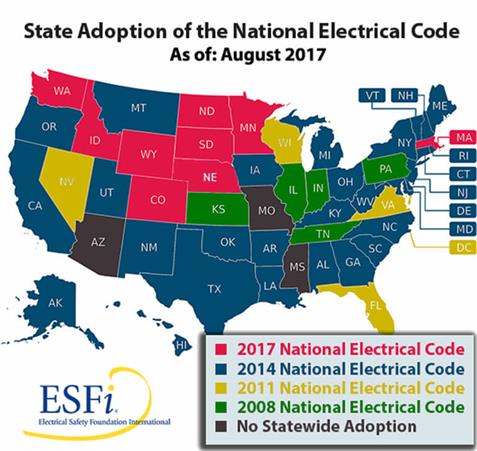
If you are familiar with the National Electrical Code (NEC), you know that there is a lot of specific information regarding the setup and installation of lights and electrical circuits. The NEC is the national standard adopted by all 50 states for safe electrical installation and inspection to protect people and property from common electrical mishaps. From NEC AFCI requirements to arc-fault interrupters and more, these requirements are subject to change.
Don’t take unnecessary risks with your home’s electrical system. Instead of potentially voiding warranties, or putting health or safety the line, talk to your Gold Medal electrical experts.
Every three years, the NEC gets updated. It’s a living document. Changes normally include more specific and easier-to-understand language, as well as new and deleted safety requirements.
Despite the fact the NEC is constantly being updated, states have to adopt each new version of their own accord.

Source: Electrical Safety Foundation International (ESFI)
For more information on NEC adoption, visit esfi.org.
In the newly updated 2017 version of the National Electrical Code, there are many updates that involve ground fault circuit interrupters (GFCIs) and arc fault circuit interrupters (AFCIs).
Whenever installing or modifying your lighting or electrical equipment, it’s important to hire a professional electrician who follows all electrical codes.
Avoid complications and leave potentially dangerous electrical work to your highly-trained team at Gold Medal. Our expert technicians are available 24 hours a day, seven days a week to help. Call now to learn how simple it is to schedule trusted electrical service for your home.
Ground-Fault Circuit Interrupters (2017 NEC Update)
Ground-fault circuit interrupters prevent shocks and electrocutions by shutting off power when a leaking current is detected. The Consumer Product Safety Commission estimates that around 50% of home electrocutions have been prevented by working GFCIs.
Circuits requiring GFCI protection are designated by the National Electrical Code. GFCI protection coverage has continued to increase every year.
Here are some of the new 2017 changes to the National Electrical Code regarding GFCI requirements:
210.1 Scope – GFCI & AFCI Requirements Overview
Article 210 provides a general overview of GFCI and AFCI protection.
210.8(A) – GFCI Locations and Measurements
In article 210.8, new information has been added about measuring and increasing GFCI requirements, including new requirements for three-phase circuits, unfinished basements, and crawl spaces.
New language in the 2017 NEC states that when determining the distance from a receptacle (such as distance from a sink or tub), distance should be measured “as the shortest path the cord of an appliance connected to the receptacle would follow without piercing a floor, wall, ceiling, or fixed barrier, or passing through a door, doorway, or window.”
While most qualified electricians were already measuring distance this way, it’s good to have official clarification.
210.8(B) – Expanded GFCI Protection (More than dwelling units)
GFCI protection is now required for larger circuits and some additional locations. The requirements for GFCI protection in dwelling units have expanded to include 250-volt, single-phase receptacles that are 50 amperes or less, in addition to the existing requirements for all 125-volt receptacles. This change helps protect against shocks and electrocutions for higher voltage receptacles.
Two new locations for GFCI protection have been added:
- 210.8(B)(9) was added for crawlspaces at or below grade level
- 210.8(B)(10) was added for unfinished portions or areas of the basement not intended as habitable rooms
Source:International Association of Electrical Inspectors
As of the 2017 NEC Update, GFCIs are required in all of the following areas:
- Underwater pool lighting (since 1968)
- Outdoors (since 1973)
- Bathrooms (since 1975)
- Garages (since 1978)
- Kitchens (since 1987)
- Crawl spaces and unfinished basements (since 1990)
- Wet bar sinks (since 1993)
- Laundry and utility sinks (since 2005)
- Crawlspaces at or below grade level (2017)
- Unfinished areas of the basement (2017)
Source: Consumer Product Safety Commission
Ground fault circuit interrupters are installed into receptacles or directly into the electrical panel to protect your electrical system from ground faults caused by wetness and moisture. The NEC governs GFCI requirements to ensure better protection from electrocution in homes.
Make sure you have working GFCI receptacles for all the areas listed above. We highly recommend testing your GFCI outlets and/or breakers every month to ensure they are in good working condition. Don’t forget about your outdoor receptacles, which should all have working ground fault circuit protection.
How to Test a GFCI
- Press down on the RESET Button.
- Make sure something is plugged in (a light, or similar device).
- Make sure the device/light is on.
- Press down on the TEST button.
- The device should turn off.
- Press down on the RESET button to turn power back on.
- The device should turn on.
The test button should turn the power off; pressing the reset button should turn the power back on again. If pressing the test button does not cut off power to the outlet, your GFCI is not working properly. Call a certified electrician to take a look.
GFCI protection can be installed directly at the breaker box or it can be installed at each individual outlet. For the best protection, we recommend installing GFCI protection at the breaker box for whole-home ground fault protection.
Arc-Fault Circuit Interrupters (2017 NEC Update)
The 2017 NEC Update has increased the requirements for arc fault circuit interrupters (AFCIs). Before 2008, AFCIs were only required to protect bedrooms. As of 2017, AFCI requirements have greatly expanded. So where are arc fault breakers required for 2017? Keep reading to find out.
Here are some of the new 2017 changes to the National Electrical Code regarding AFCIs:
210.1 Scope – GFCI & AFCI Requirements Overview
Article 210 provides a general overview of GFCI and AFCI protection.
210.12 – AFCI Protection Requirements
NEC AFCI requirements have been revised to include AFCI protection for all 120-volt, single-phase, 15- and 20-ampere branch circuits. The list of areas where AFCI protection was removed and replaced by a requirement for the entire dwelling unit. This includes guest rooms, dormitory bathrooms, and the circuits supplying outlets and devices.
To make sure your home is complying with the updated NEC, it’s best to install whole-home AFCI protection directly at the electrical panel. Speak with a qualified electrician.
406.4 – General Installation AFCI Requirements
Clarification was added about the rule that requires AFCI protection for replacement receptacles.
550.25 – Mobile Homes
AFCI protection for mobile homes mirrors the AFCI requirements for dwellings in 210.12.
AFCIs provide protection against electrical fires. Make sure they are working properly by testing them every month.
How to Test an AFCI
- Test AFCIs when the power is on
- Find and open up your electrical panel.
- With the breaker in the ON position, press the TEST button.
- The breaker should trip.
- If the breaker trips, your AFCI protection is working.
- Turn your breaker on by flipping it all the way OFF and then back ON again.
If pressing the TEST button does not trip the breaker, your AFCI is not working properly. Contact a qualified electrician to replace the AFCI.
Additional 2017 Updates to the National Electrical Code (NEC):
Listing of Equipment – new rules about who may list electrical equipment and how they should be listed (reconditioned, refurbished, or re-manufactured).
Conductor Termination and Splicing – when torquing terminal connections, the torque wrench must be properly calibrated.
Conductor Ampacity – changes have been made to the rules establishing conductor ampacities, such as cable bundling and dwelling service conductor sizing.
Conductors Connected in Parallel – there are new requirements for grouping parallel conductors.
Grounding Conductor – some air conditioning installations now require a wire-type equipment grounding conductor.
Electric Shock Drowning Signs – boat docks and marinas are now required to display a warning sign about electric shock drowning.
Tamper-Resistant Receptacles – locations requiring tamper-resistant receptacles have been greatly expanded.
If you have children at home, we highly recommend installing tamper-resistant receptacles around the home. Those plastic outlet caps are ineffective. One study found that 100% of 2-4 year-olds were able to remove the outlet caps within 10 seconds. TRRs are tamper-proof. Learn more about tamper-resistant receptacles here.
For more information on 2017 NEC requirements and how to protect your home and family from common electrical dangers, contact Gold Medal Service.


